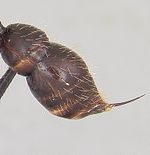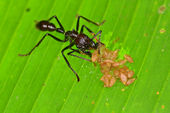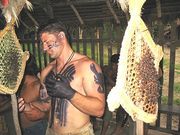Bullet ant
| Bullet ant |
|---|

|
| Scientific Classification |
|
| Scientific name |
|
Paraponera clavata |
| This is how big a bullet ant is compared to a human hand |
The Bullet Ant is a species of ant that goes by its scientific name Paraponera clavata. This ant is known for its very painful sting to both humans and animals, which is why it is called the Bullet Ant. People have compared the sting of a Bullet Ant to getting shot by a gun. Though the Bullet Ant is not a serious threat to people, it should still be taken seriously because of the immense pain of their sting. They haven't been known to take the lives of people before, so you should't worry about them being a serious threat to the world.
Though the Bullet Ant is known as a dangerous animal, they attack only because they are alarmed and are trying to protect themselves. They probably see us as a threat, so they attack us without warning. It is best to just admire them from a distance without disturbing them, so keep in mind that they are only trying to protect themselves from harm.
Body Design
The Bullet Ant is the world's largest ant, being four times the size of a regular ant.[2] It has the anatomy of a regular ant; six legs, a head with a huge pair of jaws called mandibles which are used for feeding, thorax, and abdomen. The mandibles aren't used for stinging.[2] The length of a regular worker Bullet Ant ranges from around eighteen to thirty millimeters, and they seem to resemble reddish-black wingless wasps.[3] These ants are very huge in size, and are sometimes referred to as the Giant Ant.[2]
A way to determine the difference between a regular ant and a bullet ant is that bullet ants are relatively more hairy than regular ants. Bullet ants also have more reddish-brown hairs than other ants.[3]
The stinger of a Bullet Ant contains a venom, which contains a neurotoxin that can cause extreme amounts of pain.[4] More information on this can be found in The Sting and History of Bullet Ants section of this article.
Life Cycle
The life cycle of the bullet ant starts off with the Queen Bullet Ant. Once the queen is mature enough, it will go out into the world and find a place to make a nest. Most queens like to make their nests at the bottom of trees or vines, or in tree hollows. The nests the Queen Bullet Ant makes extend up to two feet below the surface, with numerous flat-floored chambers and slightly domed ceilings. A Bullet Ant nest was discovered in 1983 that contained forty three separate chambers![5]
Once the Queen Bullet Ant finds and creates a nest, she starts producing the colony. The queen makes all the eggs for the colony. Once the eggs are laid, they go through complete metamorphosis, where the eggs hatch into larvae. The larvae then must pupate before becoming adults. The larvae tend to move to warmer parts of the nest for optimum conditions to pupate.
Ecology
Bullet Ants live in colonies formed in nests, which are usually formed at the bases of trees, as said before in the Life Cycle section of this article. There is a single entrance to the nests with many escape routes, and sometimes even a drainage system! Other openings are used to remove soil from the nest. Temperatures within the nests range from twenty-two degrees to twenty-seven degrees. Each colony contains one Queen Bullet Ant and several worker Bullet Ants.[4]
Geographically, Bullet Ants can be found in many places, mostly in Central and South America. In the northern parts of America, they inhabit the Honduras, Nicaragua, and Costa Rica. In the southern parts of America, they inhabit Colombia, Ecuador, Venezuela, Peru, and Brazil. Colonies of Bullet Ants can be found at humid lowland places between average sea level to seven-hundred fifty meters above sea level.[4]
Bullet Ants use division of labor to divide up the roles of each ant.[4] After a Bullet Ant colony has been formed by the queen, each Bullet Ant has a role to play. The larger Bullet Ants will protect the Queen Bullet Ant from any harm from predators, such as the Phorid Fly, which will be discussed on more in the topic, while the smaller ants, the worker ants, tend to the queen and her eggs.[5] Other Bullet Ants have more specific roles, such as looking for food, mostly in the trees, herbs, and grass.[4]
Bullet Ants have one main predator; the Phorid Fly. Phorid Flies will mainly go after injured or unhealthy Bullet Ants. However, they can also go after healthy Bullet Ants if they are inhibited from movement. Phorid Flies will actually lay eggs while feeding on an injured Bullet Ant. Once the Phorid Fly eggs hatch, they become parasites, making the injured Bullet Ant the host.[4]
The Sting and History of Bullet Ants
The Bullet Ant is said to have the most painful insect sting in the entire planet. In fact, as said in the Introduction, they are most famous and known for their sting. The neurotoxin in their venom travels to the nervous system in mammals, which inhibits the ability to control your muscle contractions. It is shown that the neurotoxin in the venom is actually a paralyzing peptide called Poneratoxin. Once stung, the symptoms and effects of the sting last up to twenty-four hours. Even though the sting is very painful, it is not life-threatening however.[4]
Bullet Ants are used in a ritual called the Rite of Passage. The Rite of Passage is a ritual where boys in the age of twelve to sixteen would enter from boyhood to adulthood by a certain trial they must complete. If the trial is completed, then you would be considered a man. One of the trials a child must go through is the Bullet Ant Rite of Passage. For the Bullet Ant Rite of Passage, boys must stick their hands into gloves full of Bullet Ants to see if they can endure the pain for ten minutes. If successful, you would go from boyhood to adulthood, and you would now be ready to face the challenges real men must face. This practice of boyhood to adulthood using bullet ant gloves is mainly practiced by the Satere-Mawe Indian Tribe.[4]
Video
This person shows just how painful a Bullet Ant sting can be.
References
- ↑ Paraponera Wikispecies. Web. Accessed on April 27, 2018. Unknown Author
- ↑ 2.0 2.1 2.2 Bullet Ant: 4 Spine Chilling Facts & How to Deal with the World’s Most Painful Insect Pest Wiki. Web. Accessed on April 14, 2018. Unknown Author.
- ↑ 3.0 3.1 Khalid, Waleed. Bullet Ant Facts | Anatomy, Diet, Habitat, Behavior Animals Time. Web. Accessed on April 14, 2018.
- ↑ 4.0 4.1 4.2 4.3 4.4 4.5 4.6 4.7 Bullet Ant Facts, Habitat, Sting, Bite, Pain, Size, Ritual, Venom, Glove, Pictures & Videos TreatCure. Web. Accessed on April 14, 2018. Unknown Author.
- ↑ 5.0 5.1 Team, Ben. The Reproductive System of Bullet Ants Mom.me. Web. Accessed on April 14, 2018.




